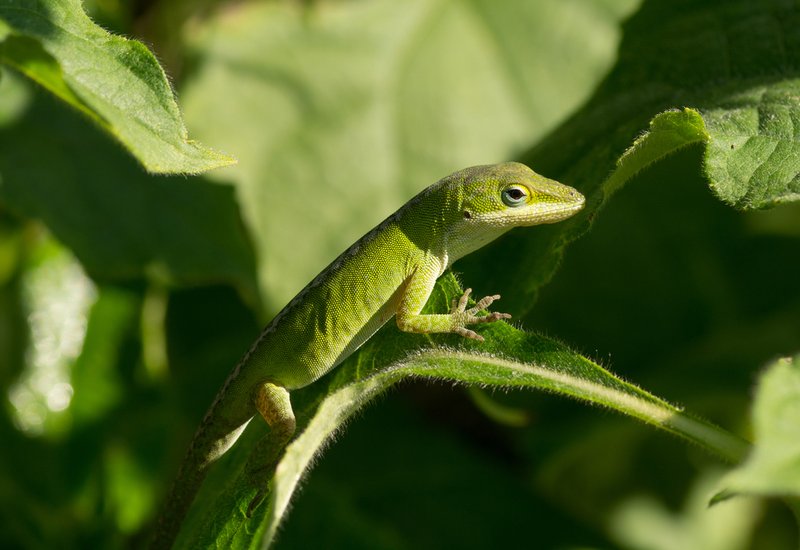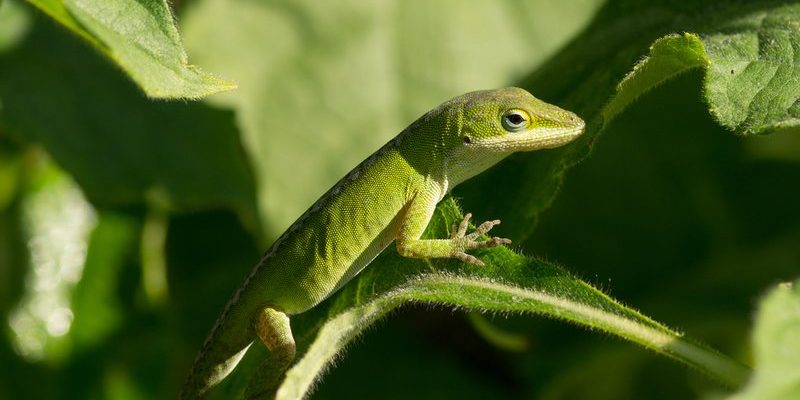
Imagine these charming lizards as nature’s own miniature superheroes. They have unique abilities and adaptations that help them thrive in their environments. Let’s dive into some of the lesser-known facts about the anole lizard and discover what makes them so special.
1. Masters of Camouflage
Anole lizards are like the chameleons of the American backyard, though they don’t quite change color in the same dramatic way. Instead, they can shift shades based on their environment. Most commonly, you’ll see the green anole, which can adapt its color from bright green to a more muted brown. This ability helps them blend in with their surroundings, dodging predators while they sunbathe or hunt insects.
You might be wondering how they pull this off. It’s all about their skin pigment and the structure underneath it. When they feel threatened or need to cool off, their skin cells can expand or contract, altering their color slightly. It’s a pretty neat trick that adds a bit of flair to their already intriguing existence!
2. The World of Display and Communication
One of the most entertaining aspects of anole lizards is their ability to communicate visually. Male anoles have a special throat flap called a dewlap. When they want to show off or attract a mate, they puff it out and extend it in vibrant colors—usually bright pink or orange. It’s like a flashy invitation to a dance party!
This display isn’t just for show; it’s also a way to assert dominance over territory. A male may engage in a little “dance-off” with another male, showcasing his stature and fitness. It’s intriguing to watch how these little lizards use such bold visuals to communicate, reminding us that even in the animal kingdom, appearances can say a lot!
3. They’re Not All Green
While many people think of anoles as vibrant green lizards, there’s a whole spectrum of colors and types out there. The green anole is perhaps the most recognized, but there are over 400 species of anole lizards worldwide, each with its own unique hues and characteristics. For instance, the brown anole is another popular species found in the southeastern United States and has a darker, more muted appearance.
Here’s the cool part: different species have adapted to various environments, ranging from rainforests to scrublands. Each type comes with its own survival techniques, so there’s a lot to explore if you dive into the world of anoles beyond the garden variety.
4. Quick and Nimble Climbers
Anole lizards are often spotted zipping up tree trunks or hanging out on branches. They’re fantastic climbers thanks to their specialized toe pads, which have tiny, hair-like structures that help them grip surfaces. This makes it easy for them to navigate branches and leaves with agility that would make a gymnast jealous.
Their zippy nature is not just for fun! It helps them evade predators and catch fast-moving prey, like insects. Ever seen an anole catch a fly mid-air? It’s impressive! Their speed and climbing skills are essential tricks for survival in the wild.
5. A Diet That’s All About Bugs
You might be surprised to learn that anoles are primarily insectivores. They feast on a variety of insects, including crickets, flies, and moths. When you spot them lurking around your backyard, they’re not just sunbathing—they’re on the lookout for their next meal.
These lizards can eat a significant number of insects in a day, helping to keep pest populations in check. So, if you’re thinking about welcoming anoles into your garden, remember, they’re not just cute; they’re also helpful little predators.
6. Breeding and Baby Anoles
When it comes to breeding, anole lizards have a pretty interesting process. After a male impresses a female with his dewlap displays, they pair up. The female lays eggs that she buries in soft soil or leaf litter, where they’ll incubate for about six to eight weeks before hatching.
The little hatchlings are tiny versions of their parents, ready to start their adventures right away. They grow quickly and can adjust to various environments, making them resilient little creatures. It’s amazing how these tiny lizards start their life with such independence and determination.
7. Habitat Variety
Anoles are quite adaptable and can be found in various habitats, from forests and swamps to urban areas. Their ability to thrive in different environments is one of the reasons they are so prevalent in many regions. You might see them in tropical places, but they also make their home in temperate climates.
This adaptability extends to their breeding and feeding habits, allowing them to occupy various ecological niches. Their versatility is essential for their survival, especially in changing climates and urban settings.
8. They Can Regenerate Tails
One of the most fascinating features of anole lizards is their ability to regenerate their tails. If an anole finds itself in a tight spot, it can drop its tail to escape a predator. This is known as autotomy. The good news? A new tail will grow back, even though it might not look exactly the same as the original.
The new tail is often made of cartilage instead of bone, which means it may not have the same strength or function as the first. However, the ability to regrow a tail provides a significant survival advantage, allowing them to escape harm and continue their lives.
9. Temperature Sensitivity
Anole lizards are ectothermic, which means they rely on external sources for body heat. This sensitivity to temperature means they often bask in the sun to regulate their body temperature. You’ll likely see them warming themselves on a rock or a branch during the cooler parts of the day.
However, they also need to cool down, especially in the heat of the day. If it gets too hot, an anole will seek shade to avoid overheating. This constant juggling act helps them maintain a balance that’s crucial for their survival.
10. A Little Conservation Challenge
While anole lizards are relatively common, some species face challenges due to habitat loss and climate change. Urbanization and deforestation can disrupt their habitats, forcing them to adapt quickly or find new homes.
Understanding their needs and protecting their environments can help ensure these little lizards continue to thrive. By planting native plants and creating habitats that welcome them, we each can contribute to their conservation.
In summary, anole lizards may be small, but they pack a punch with their fascinating traits and behaviors. From their unique color-changing skills to their playful displays, there’s a lot more than meets the eye. By appreciating these little creatures and understanding their role in our ecosystems, we can foster a greater respect for the natural world around us. Who knew something so small could be so inspiring?

